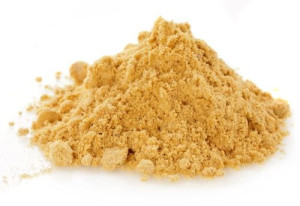Rice Protein
Table of Contents
NEWS: Rice Protein superfood is now available in the SANEStore as a convenient whole-food powder so you can more easily enjoy it in smoothies and recipes.
A high-protein alternative to soy and animal products, our natural raw enzyme sprouted Organic Oryzatein Silk Brown Rice Protein Concentrate has a silky smooth texture and higher protein content than other rice protein powders. Our Organic Orzatein Silk has 83% protein content, improved taste and is more easily digested, hypoallergenic and a vegetarian/vegan source of protein. Ideal for those with gastrointestinal sensitivity to milk, wheat, soy and other proteins. Organic Sprouted Brown Rice Protein is gluten-free, vegan and contains no milk, soy, wheat, eggs, corn, yeast, herbs, preservatives, coloring or anything artificial. This protein is made using an all natural process that does not involve the use of chemical solvents.
Rice Protein Benefits
Rice protein provides the body with nutrients called amino acids. Rice protein’s various amino acids may help to defend against excessive sugar in the circulation. They could also assist to lower blood pressure and cholesterol levels.
Rice protein is a great alternative to whey for those who are lactose intolerant. It also contains all nine essential amino acids and is high in fiber, which makes it an ideal source of protein for vegetarians and vegans.
Rice protein can be found in such health foods as cereals, smoothies, bars and even pet food because of its mild taste and biological value.
Soy allergies have driven many people towards veganism and the consumption of rice proteins over soy proteins.
Rice Protein Nutrition:
Rice protein is often used as a meat substitute because of its high biological value which comes from the glutamic acid contained in it.
1.Rice Protein Rich In Iron – Iron helps with transportation of oxygen throughout your body and aids healthy blood cells which help you feel energized and active during the day.
2.Helps With Weight Loss – Since rice protein is low in calories, it helps keep weight off while adding vitamins and nutrients to your diet.
3.It Supports The Nervous System – Many will opt for rice protein over soy if they have soy allergies and need their daily dose of amino acids (the building blocks for proteins).
4.Regulates Blood Sugar To Help Manage Diabetes Symptoms
Rice Protein Benefits For Hair?
Rice protein is an excellent source of silica, which helps make tissues stronger and healthier. Silica also stimulates hair growth by improving the health of the scalp.
Additional Health benefits of rice protein
1- Lowers Bad Cholesterol And Triglycerides
2- Lowers Blood Pressure
3- Reduces Risk Of Osteoporosis And Prevents Weak Bones
4- Strengthens The Immune System And Prevents Illness
5- Inhibits Cancerous Cell Growth In The Body
6- May Improve Brain Function
7- Helps Maintain Skin Elasticity And Smoothness By Strengthening Elastin And Collagen
8- Healthy Nails, Fingernails, And Hair.
9- May Help Relieve Symptoms Of PMS
10- Promotes A Healthy Gut Microbiota
11- Stronger Teeth 12-.Repairs Damaged Tissues Faster Because Rice Protein Is Easier To Digest
12- Weight Loss
13- Low Glycemic Index
14- Increases Energy Levels
15- Provides An Excellent Non Dairy Source Of Protein
16- Gluten Free Option
17- Improves Cardiovascular Health
18- Regulates Blood Sugar To Help Manage Diabetes Symptoms
19 -Reduce The Risk Of Osteoporosis
20 – Relieves PMS Symptoms
21 – Helps Prevent Anemia
22 – Helps Lower Blood Pressure
23- Helps Lose Weight And Maintain A Healthy Body Mass Index
24- Reduces Inflammation In The Body
25- Prevents Cancer Cell Growth
26- Improves Bone Health By Increasing Bone Mineral Density.
27- Increases Lean Muscle Mass, Strength And Stamina.
28- Assists In Preserving Lean Body Mass And Supporting Metabolism In Elderly Men And Women As They Age
29 – Improved Cognitive Function For Those Who Are Aging
30- May Help To Reduce Symptoms Of Menopause
31- Reduction Of Risk Of Heart Disease
32 – May Aid In Skin Care
33 – Supports Nerve and Brain Function
34 – May Improve Immune System
Why Try Rice Protein Superfood?
- 100% Plant-Based Protein
- Highly Soluble & Easy to Digest
- Excellent Amino Acid Profile – Especially high in Arginine, Glutamine & Leucine
- Low Sodium
- Totally raw with no heat used
- Non-GMO
- Bio-fermentation – combining the sprouted endosperm & the bran from raw sprouted whole grain brown rice
- Hypoallergenic
- 100% Gluten, Soy, & Cholesterol Free
- Environmentally Friendly Source of Protein
- Highly Suitable for Sustainable Agriculture
References
1. Anderhuber, R. 1991. Vaccinium myrtillus . Aust J Med Herbalism 3:13–14
2. Azar, M., E. Verette, S. Brun. 1987. Identification of some phenolic compounds in bilberry juice Vaccinium myrtillus. J Food Sci 52(5):1255–1257
3. Barrette, E.P. 1999. Bilberry fruit extract for night vision. Alternative Medicine Alert™ 2(2):20–21
4. Bone, K. and M. Morgan. 1997. Bilberry—The Vision Herb. MediHerb Professional Review 59:1–4
5. Braun, R. et al. 1997. Standardzulassungen für Fertigarzneimittel—Text and Kommentar. Stuttgart: Deutscher Apotheker Verlag.
6. Bravetti, G. 1989. Preventive medical treatment of senile cataract with vitamin E and anthocyanosides: clinical evaluation. Ann Ottalmol Clin Ocul 115:109
7.Bruneton, J. 1995. Pharmacognosy, Phytochemistry, Medicinal Plants. Paris: Lavoisier Publishing
8. Bundesanzeiger (BAnz). 1998. Monographien der Kommission E (Zulassungs- und Aufbereitungskommission am BGA für den humanmed. Bereich, phytotherapeutische Therapierichtung und Stoffgruppe). Köln: Bundesgesundheitsamt (BGA)
9. Caselli, L. 1985. Studio clinico ed elettroretinografico sull’attivita degli antocianosidi [Clinical and electroretinographic study on activity of anthocyanosides]. Arch Med Int (Parma) 37:29–35
10. Cluzel, C., P. Bastide, P. Tronche. 1969. [Phosphoglucomutase and glucose-6-phosphatase activities of the retina and anthocyanoside extracts from Vaccinium myrtillus (study in vitro and in vivo )] [In French]. C R Seances Soc Biol Fil 163(1):147–150
11. Colantuoni, A., S. Bertuglia, M.J. Magistretti, L. Donato. 1991. Effects of Vaccinium myrtillus anthocyanosides on arterial vasomation. Arzneimforsch 41(9):905–909.
12. Cunio, L. 1993. Vaccinium myrtillus . Aust J Med Herbalism 5(4):81–85
13. Deutscher Arzneimittel-Codex (DAC). 1986. Stuttgart: Deutscher Apotheker Verlag
14. Ferretti, C., M.J. Magistretti, A. Robotti, P. Ghi, E. Genazzani. 1988. Vaccinium myrtillus anthocyanosides are inhibitors of cAMP and cGMP phosphodiesterases. Pharm Res Comm 20(11):150
15. Fiorini, G., A. Biancacci, F.M. Graziano. 1965. Modificazioni perimetriche ed adattometriche dopo ingestione di mirtillina associata a beta-carotene [Perimetric and adaptometric modifications after ingestion of myrtillin associated with beta-carotene]. Ann Ottalmol Clin Ocul 91(6):371–386
16. Foster, S. 1996. Bilberry: A Long History. Health Food Business. August 1996: 40
17. Friedrich, V.H. and J. Schönert. 1973. Untersuchungen über einige Inhaltsstoffe der Blätter und Früchte von Vaccinium myrtillus [Phytochemical investigation of leaves and fruits of Vaccinium myrtillus ]. Planta Med 24(1):90–100
18. German Homeopathic Pharmacopoeia (GHP). 1993. Translation of the Deutsches Homöopathisches Arzneibuch (HAB 1), 1st ed., 5th suppl. 1991. Stuttgart: Deutscher Apotheker Verlag. 383–384
19. Ghiringhelli, C., F. Gregoratti, F. Marastoni. 1978. Attivita capillarotrop di antocianosidi and alto dosaggio nella stasi da flebopatia [Capillarotropic activity of anthocyanosides in high doses in phlebopathic statis]. Minerva Cardioangiol 26(4):255–276
20. Grieve, M. 1979. A Modern Herbal. New York: Dover Publications, Inc.
21. Hänsel, R., K. Keller, H. Rimpler, G. Schneider (eds.). 1992–1994. Hagers Handbuch der Pharmazeutischen Praxis, 5th ed. Vol. 4–6. Berlin-Heidelberg: Springer Verlag
22. Jayle, G.E. and L. Aubert. 1964. [Action des glucosides d’anthocyanes sur la vision scotopique et mesopique du sujet normal] [In French]. Therapie 19:171
23. Jayle, G.E. et al. 1965. [Study concerning the action of anthocyanoside extracts of Vaccinium Myrtillus on night vision] [In French]. Ann Ocul (Paris) 198(6):556–562
24. Lagrue, G. et al. 1979. Pathology of the microcirculation in diabetes and alterations of the biosynthesis of intracellular matrix molecules. Front Matrix Biol S Karger 7:324–325
25. Leung, A.Y. and S. Foster. 1996. Encyclopedia of Common Natural Ingredients Used in Food, Drugs, and Cosmetics, 2nd ed. New York: John Wiley & Sons, Inc. 84–85
26. Lietti, A., A. Cristoni, M. Picci. 1976. Studies on Vaccinium myrtillus anthocyanosides. I. Vasoprotective and antiinflammatory activity. Arzneimforsch 26(5):829–832
27. Meyer-Buchtela, E. 1999. Tee-Rezepturen—Ein Handbuch für Apotheker und Ärzte. Stuttgart: Deutscher Apotheker Verlag
28. Morazzoni, P. and E. Bombardelli. 1996. Vaccinium myrtillus L. Fitoterapia 67(1):3–29
29. Neumann, L. 1971. Therapeutische Versuche mit Anthozyanosiden bei Langzeitbehandlungen in der Augenheilkunde [In German]. Klin Monatsbl Augenheilkd 158:592–597
30. Österreichisches Arzneibuch, 1st suppl. (ÖAB). 1983. Wien: Verlag der Österreichischen Staatsdruckerei
31. Österreichisches Arzneibuch (ÖAB). 1991. Wien: Verlag der Österreichischen Staatsdruckerei
32. Pennarola, R. et al. 1980. The therapeutic action of the anthocyanosides in microcirculatory changes due to adhesive-induced polyneuritis. Gazz Med Ital 139:485–491
33. Perossini, M. et al. 1987. Diabetic and hypertensive retinopathy therapy with Vaccinium myrtillus anthocyanosides (Tegens): Double blind placebo controlled clinical trial. Ann Ottalmol Clin Ocul 113:1173
34. Pharmacopoeia Helvetica, 7th ed. Vol. 1–4. (Ph.Helv.VII). 1987. Bern: Office Central Fédéral des Imprimés et du Matériel
35. Pizzorno, J.E. and M.T. Murray. 1992. A Textbook of Natural Medicine. Seattle, WA: Bastyr University Publications
36. Politzer, M. 1977. [Experiences in the medical treatment of progressive myopia] [In German]. Klin Monatsbl Augenheilkd 171(4):616–619






